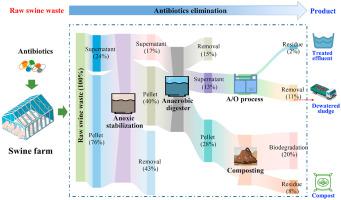Environmental Pollution ( IF 7.6 ) Pub Date : 2023-05-31 , DOI: 10.1016/j.envpol.2023.121945 Wancen Liu 1 , Yongfang Wang 1 , Ruohan Xia 1 , Xiangrui Ding 1 , Zhicheng Xu 2 , Guoxue Li 3 , Long D Nghiem 4 , Wenhai Luo 2

|
This study mapped the fate of antibiotics in a swine farm with integrated waste treatment including anoxic stabilization, fixed-film anaerobic digestion, anoxic-oxic (A/O), and composting. Results show the prevalent and consistent occurrence of 12 antibiotics in swine waste. Mass balance of these antibiotics was calculated to track their flow and evaluate their removal by different treatment units. The integrated treatment train could effectively reduce antibiotic loading to the environment by 90% (measured as combined mass of all antibiotic residues). Within the treatment train, anoxic stabilization as the initial treatment step, accounted for the highest contribution (43%) to overall antibiotic elimination. Results also show that aerobic was more effective than anaerobic regarding antibiotic degradation. Composting accounted for an additional of 31% removal of antibiotics while anaerobic digestion contributed to 15%. After treatment, antibiotic residues in the treated effluent and composted materials were 2 and 8% of the initial antibiotic loading in raw swine waste, respectively. Ecological risk assessment showed negligible or low risk quotient associated with most individual antibiotics released into the aquatic environment or soil from swine farming. Nevertheless, antibiotic residues in treated water and composted materials together showed significant ecological risk to water and soil organisms. Thus, further work to improve treatment performance or develop new technologies is necessary to reduce the impact of antibiotics from swine farming.
中文翻译:

猪粪处理中抗生素的出现和归宿:一个工业案例
本研究绘制了抗生素在采用综合废物处理(包括缺氧稳定、固定膜厌氧消化)的养猪场中的去向、缺氧-好氧 (A/O) 和堆肥。结果显示猪粪便中普遍且一致地存在 12 种抗生素。计算这些抗生素的质量平衡以跟踪它们的流动并评估它们被不同处理单元去除。综合处理系统可以有效地将环境中的抗生素负荷减少 90%(以所有抗生素残留物的总质量衡量)。在治疗序列中,缺氧稳定作为初始治疗步骤,对总体抗生素消除的贡献最大 (43%)。结果还表明,在抗生素降解方面,有氧比厌氧更有效。堆肥额外去除了 31% 的抗生素,而厌氧消化则贡献了 15%。治疗后,经处理的污水和堆肥材料中的抗生素残留分别是生猪粪便中初始抗生素含量的 2% 和 8%。生态风险评估显示,与大多数从养猪场释放到水生环境或土壤中的抗生素相关的风险系数可忽略不计或较低。然而,经过处理的水和堆肥材料中的抗生素残留对水和土壤生物体显示出显着的生态风险。因此,进一步努力提高治疗效果或开发新的 经处理的水和堆肥材料中的抗生素残留对水和土壤生物体显示出重大的生态风险。因此,进一步努力提高治疗效果或开发新的 经处理的水和堆肥材料中的抗生素残留对水和土壤生物体显示出重大的生态风险。因此,进一步努力提高治疗效果或开发新的技术对于减少养猪业中抗生素的影响是必要的。











































 京公网安备 11010802027423号
京公网安备 11010802027423号